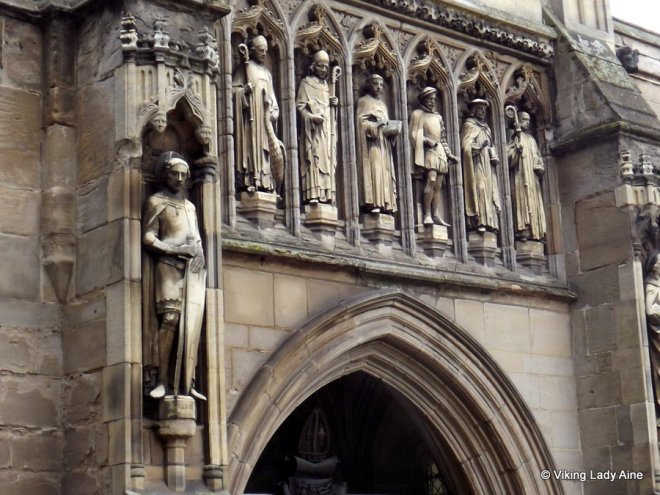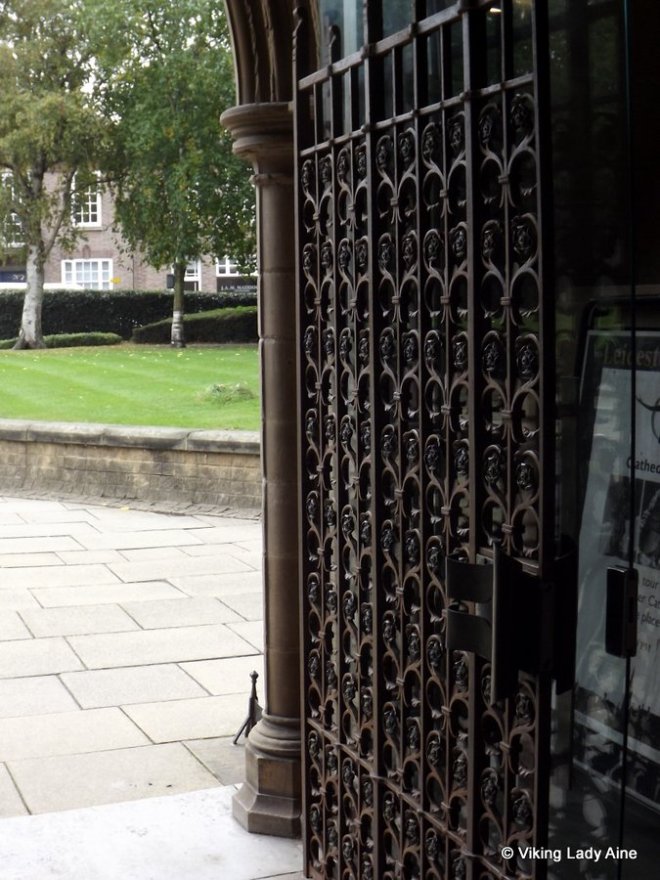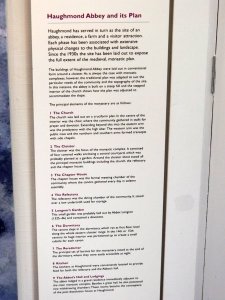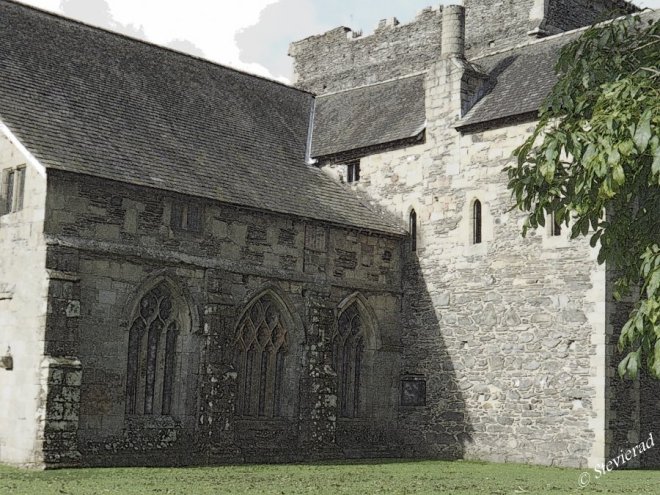I keep seeing these ads on the telly for the re-interment of the remains of Richard III in Leicester. You might remember him as the King in the Car Park, whose remains were discovered in Greyfriars in September 2012.
We had visited the Cathedral and exhibition back in 2013 (I’d planned to write this back then but the real world got in the way!!). We had already been to the Bosworth Field site to learn more about the actual battle, but this was a chance to see a little bit more.
All the photos included here are a year old; apparently the Cathedral has undergone some serious building works in preparation for the reburial, but I thought I would include them anyway.
At that time there was a very basic exhibition centre in the Guildhall , but there were plans for a more extensive structure. The former Alderman Newton’s School, located right next to the spot where the king’s remains were found, was purchased and transformed into a new Exhibition Centre. The former school – a Victorian Gothic revival building built partly on the site of the former Grey Friars Church and in the heart of Leicester’s Old Town – had stood empty since 2008 when its last occupants, Leicester Grammar School, moved out. The car park looked much like a building site when we were there (there were further digs planned), and it was strange to think of Richard lying there for over 500 years. I loved the Bear standing guard over the car park from the roof of an adjoining building. The Bear and Ragged Staff was the symbol of the Earl of Warwick, who was a huge presence in Richards early life, but was later used by Robert Dudley, Earl of Leicester.
This slideshow requires JavaScript.
Leicester Cathedral itself is a beautiful building. There has been a church dedicated to St Martin on the site for about a thousand years, with the first one recorded in 1086, when the older Saxon church was replaced by a Norman one. The present building is a Grade II* listed building and dates to about that age. The spire was added in 1862, and there have been various restorations throughout the years.

 We entered through Vaughans Porch on the south side of the cathedral. This is so-named for the carved saints over the door set in sandstone niches, all of whom are listed below.
We entered through Vaughans Porch on the south side of the cathedral. This is so-named for the carved saints over the door set in sandstone niches, all of whom are listed below.
- Guthlac c 673–713 was a Christian saint from Lincolnshire who lived when Leicester was first made a diocese in the year 680
- Hugh of Lincoln c 1135–1200 was a French monk who founded a Carthusian monastery and worked on the rebuilding of Lincoln Cathedral after an earthquake destroyed it in 1185. In Norman times Leicester was situated within the Diocese of Lincoln.
- Robert Grosseteste c 1175–1253 was an English statesman, scholastic philosopher, theologian, scientist and Bishop of Lincoln. He is also the most famous of the medieval Archdeancons of Leicester.
- John Wycliffe c 1329–1384 was an Oxford scholar and is famous for encouraging two of his followers to translate the bible into English. Foxe’s famous “Book of Martyrs” (which commemorates the Protestant heroes of the reformation era) begins with John Wycliffe.
- Henry Hastings c 1535–1595 was the 3rd Earl of Huntingdon. The Leicester home of the Earls of Huntingdon was in Lord’s Place off the High Street in Leicester, and Mary, Queen of Scots stayed there as a prisoner on her journey to Coventry.
- William Chillingworth 1602–1643 was an Oxford theologian, a friend of Jeremy Taylor and nephew of Archbishop Laud. He was Master of Wyggeston Hospital and became a Chaplain to the Royalist army in the Civil War.
- William Connor Magee 1821–1891 was Bishop of Peterborough and encouraged the building of many of Leicester’s famous Victorian churches and a large number of parochial schools. He appointed the first suffragan Bishop of Leicester, Francis Thichnesse, in 1888. Magee later became Archbishop of York.



There are three separate chapels in the cathedral, each dedicated to a separate saint.
The side chapels are St Katherine,s and St Dunstan’s and are used for small services and vigils. St Georges chapel is at the rear of the cathedral and commemorates the armed forces, especially those from Leicester who have been killed in past conflicts. Hanging overhead are a collection of colours from those forces. These are the battle honours of the Regiment, and the names of those killed in the Crimean, South African and two World Wars are recorded and remembered; standing there you cannot help but think of the number of battles those flags were carried into and the number of young and old men who gave their lives. Dulce et decorum est……….
This slideshow requires JavaScript.
I’ve added a few photos of the interior of the church. Like I said, the photos were taken a year ago and there have been changes with the planned reburial. But it is a beautiful church and well worth a visit.
This slideshow requires JavaScript.
At the time there was a memorial slab to the memory of Richard III in the main chancel of the church. I’m presuming the new tomb will replace this.
 We popped across the street to the Guildhall where the exhibition was housed at that time. There were a number of battle field artefacts from the battlefield at Bosworth where Richard was killed and also exhibits about his life and kingship. Most of this I had seen before in Bosworth, but there was an exquisite 15th century alabaster sculpture with the Yorkist symbols of the Sun in Splendour and the White Rose.
We popped across the street to the Guildhall where the exhibition was housed at that time. There were a number of battle field artefacts from the battlefield at Bosworth where Richard was killed and also exhibits about his life and kingship. Most of this I had seen before in Bosworth, but there was an exquisite 15th century alabaster sculpture with the Yorkist symbols of the Sun in Splendour and the White Rose.


 The details of the reburial and the planned routes are on the King Richard in Leicester website. Hopefully this time he will rest in peace.
The details of the reburial and the planned routes are on the King Richard in Leicester website. Hopefully this time he will rest in peace.

 Behind the street frontage there was the most wonderful little courtyard. You can see the spire of the cathedral over the roof. I can just imagine killing time sitting on that bench with a book.
Behind the street frontage there was the most wonderful little courtyard. You can see the spire of the cathedral over the roof. I can just imagine killing time sitting on that bench with a book.
 Inside on the ground floor is The Mayors Parlour. The room is dominated by a fireplace with a wonderful over mantel. It was build in 1637.
Inside on the ground floor is The Mayors Parlour. The room is dominated by a fireplace with a wonderful over mantel. It was build in 1637. The mayors chair is there as well, and there is also a seat for the representative of the ruler of the land. It has the motto of the Monarch of the United Kingdom (Dieu et mon Droit) over the seat. Mind you it looks a bit uncomfortable!
The mayors chair is there as well, and there is also a seat for the representative of the ruler of the land. It has the motto of the Monarch of the United Kingdom (Dieu et mon Droit) over the seat. Mind you it looks a bit uncomfortable!












































